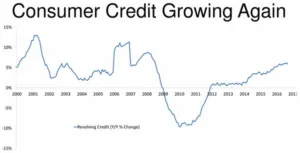Dr. Shawn DuBravac, Chief Economist at the Consumer Technology Association (CTA), presented his forecasts for the Holiday selling season and beyond, through 2020 in some cases, at CES Unveiled in New York on November 10th.
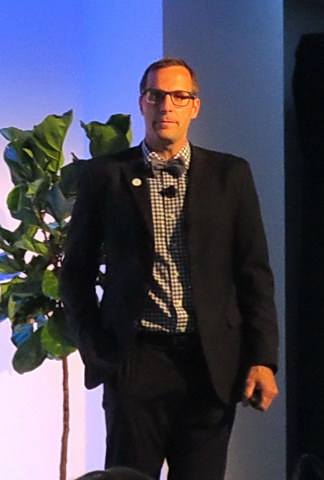 Dr. Shawn DuBravac speaking at CES Unveiled in New York (Photo: M. Brennesholtz)
Dr. Shawn DuBravac speaking at CES Unveiled in New York (Photo: M. Brennesholtz)
The CTA holiday forecast for 2016 is given in the image and shows a 3.8% overall growth for all holiday sales, including tech and non-tech items. GAFO (General Merchandise, Apparel and Accessories, Furniture and other sales) growth is modest at best at 0.5%). Growth in tech sales is better, 3.1%, with the highest growth in the mobile sales channel, followed by on-line sales.
 CTA Holiday Forecasts (Images: CTA)
CTA Holiday Forecasts (Images: CTA)
Boring down into only technology sales, the CTA expects a growth of 3.1% for 2016. While this modest growth is better than last year and comparable to the average growth since the start of the Great Recession in 2008, it is still relatively poor compared to either the 10 year or the 20 year average. Other than a few bad years, growth in the sales of technology over the 1961 – 2007 period was significant and continuous.
Consumer revolving credit (Image: CTA)
This growth is fueled, in part, by the growth in consumer credit that is used to finance major technology purchases such as TVs, computers and tech-laden automobiles. Consumer credit, pre-Great Recession in 2008, fluctuated significantly from year to year and then fell catastrophically at the start of the Great Recession. It has now recovered to roughly the pre-2008 averages.
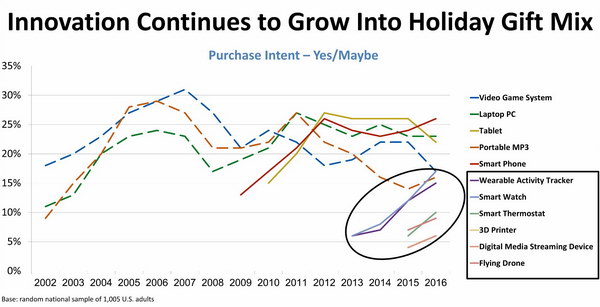 Consumer purchase intent (Image: CTA)
Consumer purchase intent (Image: CTA)
Consumer purchase intent is determined by the CTA from a consumer survey of 1005 people. Originally, in 2002, the CTA only tracked three categories, video game systems, laptop PCs and portable MP3 players. Numerous additional categories have been added since then, which is in itself a telling commentary on the growth of consumer electronics technology. Most of the growth in purchase intent has been in the newly added categories, especially in smart watches and wearable activity trackers. The purchase intent for these two categories is now comparable to the intent for video game systems and MP3 players but is still well below smartphones, tablets and laptop PCs.
Note this CTA purchase intent survey only covers hardware sales of consumer electronics. The CTA changed its name from the Consumer Electronics Association to the Consumer Technology Association in recognition that there is much more to consumer technology than consumer electronics hardware. While this survey doesn’t seem to recognize the shift, the CTA, in it’s choice of a keynote speaker for CES 2017, announced at CES Unveiled, is recognizing this trend. The CES 2017 Keynote Speaker will be Arnold Donald, President and CEO of Carnival Corporation. Carnival Corporation operates Carnival and eight other cruise lines. Modern cruise ships are absolutely packed with consumer technology. One example is the virtual balcony, which involve 80” LCDs and Red cameras, that gives even inside cabins a full HD view of the ocean. The views were so realistic, banisters had to be installed to keep people from “falling out” of the virtual window. While the automobile companies show their products at CES, I don’t think we’ll see a cruise ship in Las Vegas.
In addition to specific forecasts, Dr. DuBravac discussed CTA’s five technology trends to watch for at the upcoming CES 2017 in Las Vegas. These trends include:
- The new voice of computing,
- Connections and computations,
- Transportation transformation,
- AI’s infusion into our lives and businesses and
- Digitizing the consumer experience.
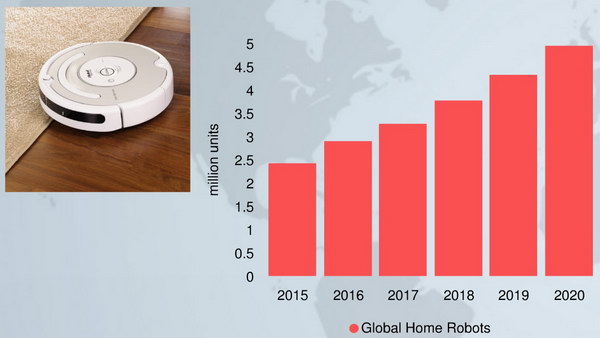 Worldwide growth of home robots 2015 – 2020 (Image: CTA)
Worldwide growth of home robots 2015 – 2020 (Image: CTA)
The new voice of computing. According to Dr. DuBravac, voice commands began to supplement graphical user interfaces (GUIs) in about 2010. He used home robots as an example of a consumer technology where voice commands are essential to their operation. The CTA forecasts that this category will grow significantly going forward to 2020, as shown in the image.
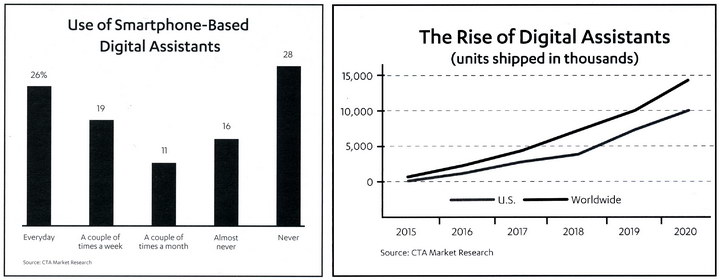 Voice command according to CTA market research (Images: CTA)
Voice command according to CTA market research (Images: CTA)
Current smartphone voice command using systems like Apple’s Siri is shown in the left hand graph. This shows what, perhaps, most people already knew – users either use the smartphone voice command or they don’t and there are relatively few people who only use it only occasionally. The right hand graph shows how the CTA expects the use of digital assistants to grow through 2020, both in the US and worldwide. These digital assistants are dedicated systems like Amazon’s Echo and do not include smartphone-based voice command systems. As I mentioned in Displays at CES Unveiled (Subscription required), this trend toward voice command will have an indirect effect on the display community in that with voice command, no display is required. For example, there is no display built into the Amazon Echo although the Echo will connect to multiple display-containing devices. This will limit the growth of displays to a lower level than the overall growth of consumer technology.
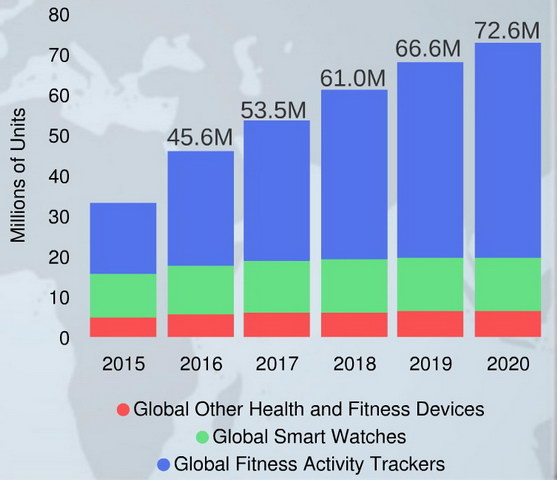 CTA forecast for the growth of connected wearable devices (Image: CTA)
CTA forecast for the growth of connected wearable devices (Image: CTA)
Connections and computations. This refers to the trend of increasing interconnections between consumer devices. DuBravac called it (rather confusingly) “Software eating hardware, Hardware eating software.” This connectivity is especially associated with both the Smart Home and wearable devices, including smart watches and health and fitness devices. The CTA estimates the smart home will be a $25B business in 2016 but they did not give a forecast through 2020. The wearable devices forecast is shown above, with the most growth expected in the fitness activity trackers. Note that this graph is a unit volume graph. Since smart watches can be expensive compared to fitness trackers, they would have a larger share of a revenue growth forecast.
Transportation transformation. From the CTA’s point of view, this trend refers mainly to self driving vehicles and driver assist technologies. To a lesser degree, it includes drones. He said there will be 18.5K net square meters (199K sq. ft.) of space at CES 2017 dedicated to the entire ecosystem of these technologies. One of DuBravac’s slides featured the Faraday Future car from LeEco so clearly the CTA doesn’t have the same doubts about this car that Autoblog.com expressed. While the CTA did not provide any autonomous car forecasts of its own, it did quote Mark Fields, Ford President and CEO, who said, “Ford will be mass-producing vehicles with full autonomy within five years. And that means there will be no steering wheel, no gas pedals and no brake pedals.”
AI’s infusion into our lives and businesses. DuBravac didn’t say too much about this trend except you should look for it at CES 2017. He used IBM’s Watson and Amazon’s Echo as two example of Artificial Intelligence (AI) technology. In a sense, he’s right, AI isn’t located in a single product or product category, it is a technology used in all modern consumer products. Everything from self-driving cars to context-sensitive menus includes AI to some degree. Looking for AI is like looking for semiconductor chips – the two technologies are so universal, you can miss the forest for the trees.
Digitizing the consumer experience. This is another trend DuBravac touched on only briefly. I believe you will be hard-pressed to find something at CES 2017 that isn’t digital. He briefly mentioned the future of entertainment, with augmented reality, virtual reality and mixed reality. He also said to expect to see a few surprises at CES. Well, of course! Why else would a tech writer or digital news person (the audience at CES Unveiled) go to CES 2017 if he didn’t expect to be surprised?
Dr. DuBravac’s complete presentation can be viewed Here. Some portions of this article came from the 24 page CTA booklet passed out at CES Unveiled and titled “5 Technology Trends to Watch.” Articles in this handout include:
- Tech Marches On, a cover letter by Gary Shapiro
- Making the World More Accessible by Steve Ewell
- Digital Assistants: Hired Help for the Smart Home by Jack Cutts
- Augmented Reality: Converging Worlds by Bill Belt
- The Future of Transportation by Brian Markwalter
- Medical Tech at a Crossroads by Mark Chisholm
- Enhancing Sports Tech by Justin Siraj
The booklet was published as a supplement to the CTA’s i3 magazine. The complete booklet can be downloaded in PDF format Here. The fact that the booklet covered six technology trends, I’ll pass over gently. –Matthew Brennesholtz

